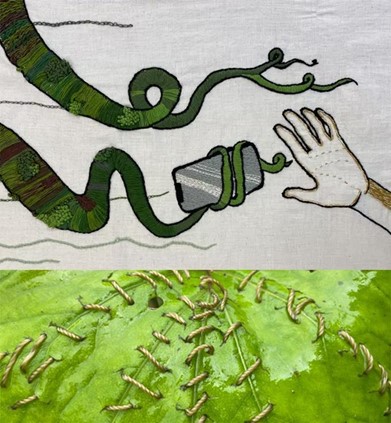Embodied eco-embroidery
Creative craftsmanship in sustainable STEAM-education
DOI:
https://doi.org/10.7577/ar.5339Emneord (Nøkkelord):
embroidery, quality education, transdisciplinary, craftsmanship, STEAM-educationSammendrag
The UN Sustainable Development Goal 4 (SDG4) addresses equal access to quality education, focusing on literacy, numeracy and the science-field STEM subjects (Science, Technology, Engineering, Mathematics), - seemingly forgetting the importance of developing practical skills like craftsmanship. STEAM includes Arts into STEM, where the arts represent several independent artistic forms including music, theater, dance, visual arts, crafts and so on.
In this article we focus on education for sustainable development through craftsmanship in embroidery. In a transdisciplinary collaboration that includes art, craftsmanship has its own innate value. Our research question is: In which ways can creative collaboration in embroidery enhance a sustainable STEAM education learning experience?
We attempt to find answers to this by looking into how STEAM collaboration may affect the ways we teach craftsmanship, and the challenges and opportunities of doing so in a holistic transdisciplinary project, with a focus on ecological sustainability.
Three groups of teacher-students help examine how crafts may contribute in building ecological awareness in themselves and an audience through conveying meaningful artistic narratives. Their embroideries were inspired by the UN’s Decade of Ecosystem Restoration. The results were shared through the Global Science Opera, an international STEAM-education initiative.
Our analysis of the research data is influenced by posthumanizing creativity, which emphasizes ethically contributing world citizenship through embodied, collaborative creativity between creator and creation. This journey of making and being made shows a reciprocal relationship between humans and non-humans. The slow-art of embroidery invites the students into an embodied dialogue with the materials, tools, techniques and the scientific topics in the transdisciplinary context. As researchers we wonder how this dialogue and in-depth experience affected the students’ attitudes and actions towards sustainability. We found that the data supports the embodied, co-creative embroidery process, that it improved the students' craft experience, as well as increased the understanding and respect for the challenges in the new eco-reality.
Cover image: Sewing in nature, on nature, with nature, about nature. Student work. Photos: Randi Veiteberg Kvellestad and Raquel Sans

Nedlastinger
Publisert
Hvordan referere
Utgave
Seksjon
Lisens
Opphavsrett 2023 Randi Veiteberg Kvellestad, Janne Iren Robberstad

Dette verket er lisensiert under Creative Commons Attribution 4.0 International License.
Forfattere som publiserer med dette tidsskriftet må være enige i følgende vilkår:
a) Forfattere beholder opphavsrett, men gir tidsskriftet rett til første publikasjon med arbeidet, samtidig som artikkelen er lisensiert under en Creative Commons Attribution-lisens som tillater andre å dele arbeidet med en anerkjennelse og referanse til forfatterskap og første publikasjon i dette tidsskriftet.
b) Forfattere må ikke inngå separate, ytterligere kontraktsmessige ordninger for eksklusiv distribusjon av artikkelens publiserte versjon av arbeidet (for eksempel legge det til et institusjonelt arkiv eller publisere det i en fagbok), uten referanse en anerkjennelse av hvor artikkelen først ble publisert. Dette gjelder for eksempel artikler som publiseres i Nordisk Barnehageforskning og som senere blir del av et doktorgradsarbeid. Da er det viktig å ha tydelige referanser til hvor og når artikkelen er publisert første gang.
c). Forfattere kan ikke legge inn sine arbeid på nettet eller publisere dem i en doktoravhandling (for eksempel i institusjonelle arkiv eller på en hjemmeside) før eller under innsendings- og fagfellevurderingsprosessen, da dette kan skape uorden i referansesystemet til artikkelen.